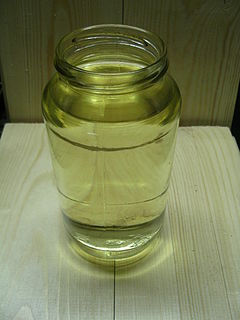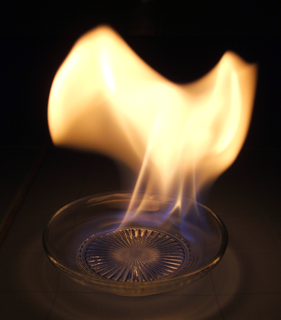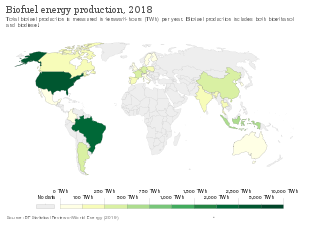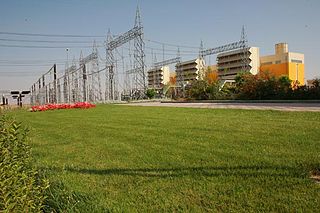Related Research Articles

Gasoline or petrol is a transparent, petroleum-derived flammable liquid that is used primarily as a fuel in most spark-ignited internal combustion engines. It consists mostly of organic compounds obtained by the fractional distillation of petroleum, enhanced with a variety of additives. On average, a 160-liter (42-U.S.-gallon) barrel of crude oil can yield up to about 72 liters of gasoline after processing in an oil refinery, depending on the crude oil assay and on what other refined products are also extracted. The characteristic of a particular gasoline blend to resist igniting too early is measured by its octane rating, which is produced in several grades. Tetraethyl lead and other lead compounds, once widely used to increase octane ratings, are no longer used except in aviation and off-road and auto-racing applications. Other chemicals are frequently added to gasoline to improve chemical stability and performance characteristics, control corrosiveness, and provide fuel system cleaning. Gasoline may contain oxygen-containing chemicals such as ethanol, MTBE, or ETBE to improve combustion.

The 1979Oil Crisis, also known as the 1979 Oil Shock or Second Oil Crisis, was an energy crisis caused by a drop in oil production in the wake of the Iranian Revolution. Although the global oil supply only decreased by approximately four percent, the oil markets' reaction raised the price of crude oil drastically over the next 12 months, more than doubling it to $39.50 per barrel ($248/m3). The spike in price caused fuel shortages and long lines at gas stations similar to the 1973 oil crisis.
Fuel efficiency is a form of thermal efficiency, meaning the ratio of effort to result of a process that converts chemical potential energy contained in a carrier (fuel) into kinetic energy or work. Overall fuel efficiency may vary per device, which in turn may vary per application, and this spectrum of variance is often illustrated as a continuous energy profile. Non-transportation applications, such as industry, benefit from increased fuel efficiency, especially fossil fuel power plants or industries dealing with combustion, such as ammonia production during the Haber process.
A fuel tax is an excise tax imposed on the sale of fuel. In most countries the fuel tax is imposed on fuels which are intended for transportation. Fuels used to power agricultural vehicles, and/or home heating oil which is similar to diesel are taxed at a different, usually lower rate. The fuel tax receipts are often dedicated or hypothecated to transportation projects so that the fuel tax is considered by many a user fee. In other countries, the fuel tax is a source of general revenue. Sometimes, the fuel tax is used as an ecotax, to promote ecological sustainability. Fuel taxes are often considered by government agencies such as the Internal Revenue Service as regressive taxes. India has the highest taxes on fuel in the world.

A natural gas vehicle (NGV) is an alternative fuel vehicle that uses compressed natural gas (CNG) or liquefied natural gas (LNG). Natural gas vehicles should not be confused with autogas vehicles powered by liquefied petroleum gas (LPG), mainly propane, which is a fuel with a fundamentally different composition.
Ethanol, an alcohol fuel, is an important fuel for the operation of internal combustion engines that are used in cars, trucks, and other kinds of machinery.

From the mid-1980s to September 2003, the inflation-adjusted price of a barrel of crude oil on NYMEX was generally under US$25/barrel in 2008 dollars. During 2003, the price rose above $30, reached $60 by 11 August 2005, and peaked at $147.30 in July 2008. Commentators attributed these price increases to many factors, including Middle East tension, soaring demand from China, the falling value of the U.S. dollar, reports showing a decline in petroleum reserves, worries over peak oil, and financial speculation.

Iran’s automotive industry is the third most active industry of the country, after its oil and gas industry, accounting for 10% of Iran's GDP and 4% of the workforce.

Autogas is the common name for liquefied petroleum gas (LPG) when it is used as a fuel in internal combustion engines in vehicles as well as in stationary applications such as generators. It is a mixture of propane and butane.

Various alcohols are used as fuel for internal combustion engines. The first four aliphatic alcohols are of interest as fuels because they can be synthesized chemically or biologically, and they have characteristics which allow them to be used in internal combustion engines. The general chemical formula for alcohol fuel is CnH2n+1OH.

Brazil is the world's second largest producer of ethanol fuel. Brazil and the United States have led the industrial production of ethanol fuel for several years, together accounting for 85 percent of the world's production in 2017. Brazil produced 26.72 billion liters, representing 26.1 percent of the world's total ethanol used as fuel in 2017.

National Iranian Oil Refining and Distribution Company (NIORDC) is part of the Ministry of Petroleum of Iran. NIORDC was established on 8 March 1991 and undertook to perform all operations relating to refining and distribution of oil products.

The usage and pricing of gasoline results from factors such as crude oil prices, processing and distribution costs, local demand, the strength of local currencies, local taxation, and the availability of local sources of gasoline (supply). Since fuels are traded worldwide, the trade prices are similar. The price paid by consumers largely reflects national pricing policy. Most countries impose taxes on gasoline (petrol), which causes air pollution and climate change; whereas a few, such as Venezuela, subsidize the cost. Some country's taxes do not cover all the negative externalities, that is they do not make the polluter pay the full cost. Western countries have among the highest usage rates per person. The largest consumer is the United States.
The energy policy of India is largely defined by the country's expanding energy deficit and increased focus on developing alternative sources of energy, particularly nuclear, solar and wind energy. India attained 63% overall energy self-sufficiency in 2017.

Iran has the fourth largest oil reserves and the largest natural gas reserves in the world. The nation is a member of OPEC, and generates approximately 50% of state revenue through oil exports.
Iranian petrol rationing riots started on 27 June 2007 when the Iranian government introduced petrol rationing. Iranians set fire to at least 12 petrol stations in Tehran, chanting that President Mahmoud Ahmadinejad must be killed.

Energy subsidies are measures that keep prices for customers below market levels, or for suppliers above market levels, or reduce costs for customers and suppliers. Energy subsidies may be direct cash transfers to suppliers, customers, or related bodies, as well as indirect support mechanisms, such as tax exemptions and rebates, price controls, trade restrictions, and limits on market access.

The use of biofuels varies by region. The world leaders in biofuel development and use are Brazil, United States, France, Sweden and Germany.

The economy of Iran includes a lot of subsidies. The Iranian targeted subsidy plan, also known as the subsidy reform plan, was passed by the Iranian Parliament in 2010. The government described the subsidy plan as the "biggest surgery" to the nation's economy in half a century and "one of the most important undertakings in Iran's recent economic history". The goal of the subsidy reform plan is to replace subsidies on food and energy with targeted social assistance, in accordance with a Five Year Economic Development Plan and a move towards free market prices in a 5-year period. The subsidy reform plan is the most important part of a broader Iranian economic reform plan.

The world's top ethanol fuel producers in 2011 were the United States with 13.9 billion U.S. liquid gallons (bg) and Brazil with 5.6 bg, accounting together for 87.1% of world production of 22.36 billion US gallons. Strong incentives, coupled with other industry development initiatives, are giving rise to fledgling ethanol industries in countries such as Germany, Spain, France, Sweden, China, Thailand, Canada, Colombia, India, Australia, and some Central American countries.
References
- Ahmadinejad’s Gas Revolution: A Plan to Defeat Economic Sanctions by Anne Korin and Gal Luft, December 2006

